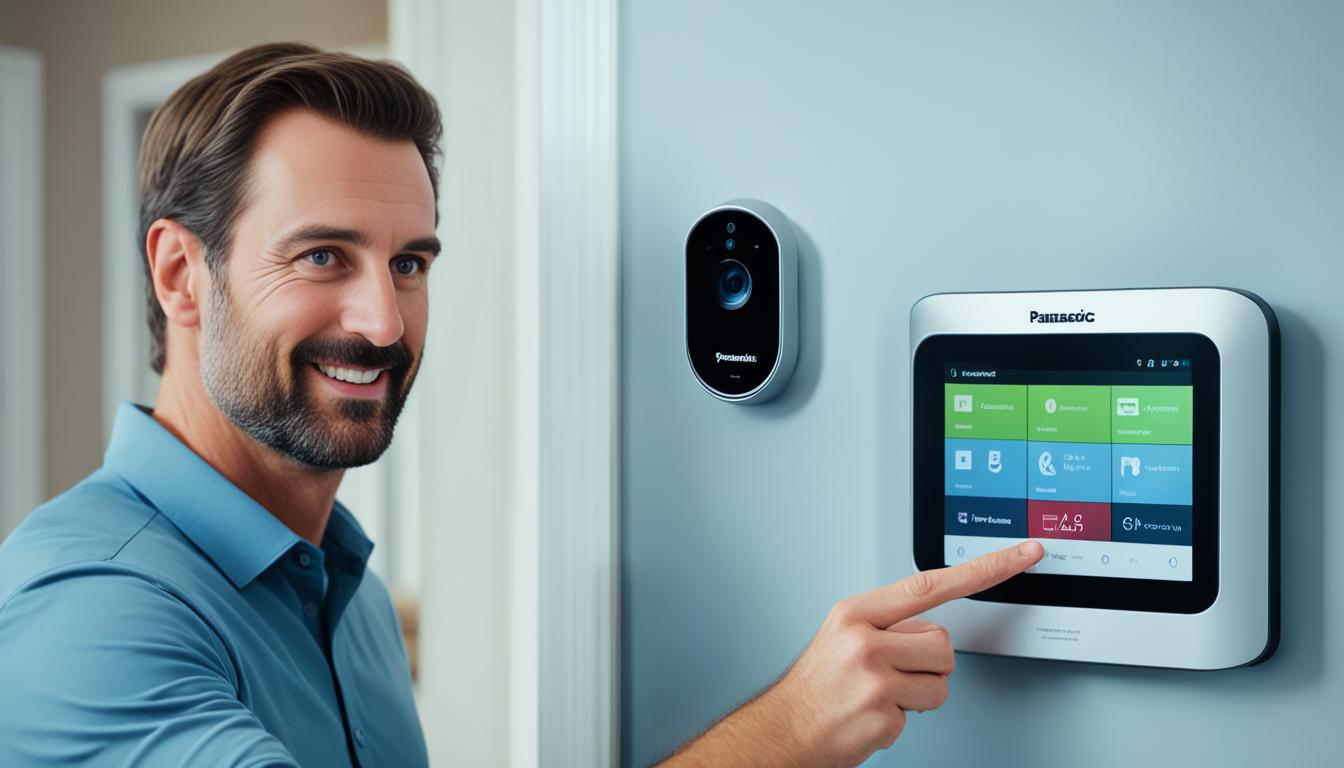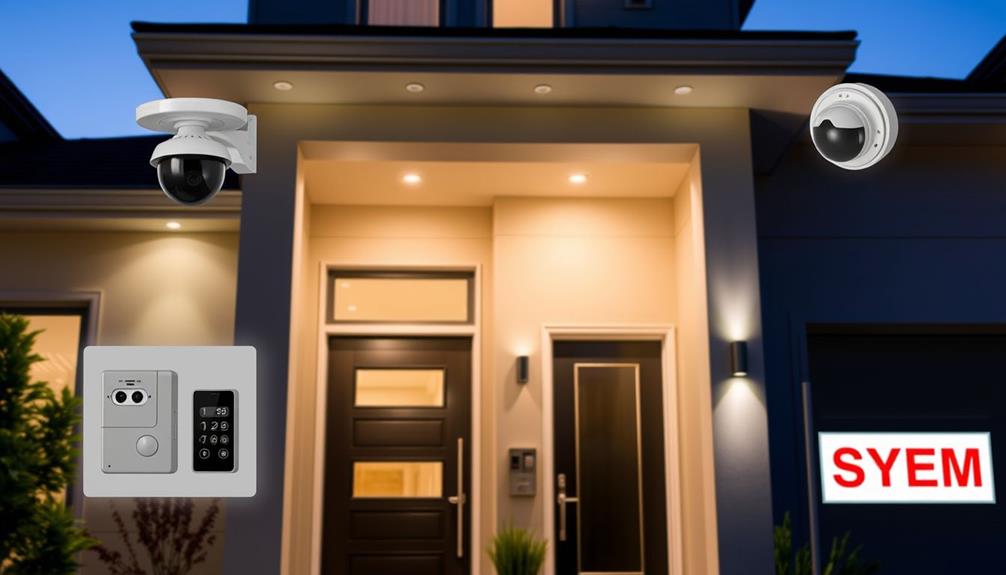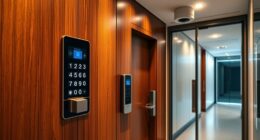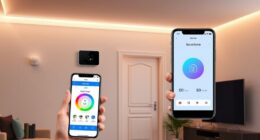When designing a home security system, it is important to first assess your individual security needs and vulnerabilities. Identify entry points such as doors and windows that require protection. Select key components like entry sensors, motion detectors, and security cameras that offer high-quality video. Consider whether professional monitoring, DIY systems, or a combination of both is the best fit for your budget and lifestyle. Incorporate smart home technology for added control, such as smart locks and alerts. Remember to schedule regular maintenance and updates to ensure your system remains effective. There is a wealth of information to explore when creating the ideal security solution for your home.
Key Takeaways
- Assess your home's vulnerabilities, focusing on entry points and high-risk areas for targeted security measures.
- Choose essential components like entry sensors, motion detectors, and security cameras to enhance protection.
- Explore monitoring options, including professional, self-monitoring, or hybrid solutions that suit your budget and lifestyle.
- Integrate smart home technology, such as smart locks and centralized control, for improved security and convenience.
Assess Your Security Needs
To design an effective home security system, start by evaluating your specific vulnerabilities, focusing on entry points like doors and windows.
Identify which areas of your home are most at risk. Pay attention to high-risk spots such as secluded entrances or dark corners that could benefit from additional surveillance or lighting.
Heat pumps, similar to security systems, can also be optimized for efficiency and reliability, particularly in home environments enhancing home comfort.
Next, consider your lifestyle and daily routines. Think about when your home is most vulnerable—are you out during the day for work, or do you often travel? This understanding will help you prioritize security measures during those times.
Don't forget to assess crime statistics in your neighborhood. Past incidents can give insight into your security needs and help you gauge the level of protection necessary for your home.
Choose Essential Components

After evaluating your security needs, it's time to choose the key components that will form the backbone of your home security system. By selecting the right elements, you can create a robust defense against potential threats.
Consider integrating smart home products such as advanced garage door openers for added security at entry points. Start with a base station and keypad as the control hub for your alarm system. This setup allows you to easily manage all connected smart home products.
Next, install Entry Sensors on all accessible doors and windows to detect unauthorized access, providing the first layer of defense. Incorporate motion sensors in key areas to monitor movement and enhance security coverage.
Don't forget to include security cameras for real-time monitoring. Look for options with at least 1080p resolution to guarantee clear video quality.
Here's a quick list of essential components for your system:
- Base station and keypad
- Entry Sensors for doors and windows
- Motion sensors for indoor areas
Explore DIY Vs. Professional Systems

Deciding between a DIY home security system and a professional installation can greatly impact your overall security experience and satisfaction.
DIY home security systems offer you the flexibility to customize your setup based on your specific needs. You can choose components from various brands, allowing for a tailored approach that fits your lifestyle. Additionally, with advancements in AI in Cybersecurity, many DIY systems now incorporate intelligent features that enhance threat detection and response times. However, you'll need to invest time and effort into installation and maintenance.
On the other hand, professional monitoring provides you with peace of mind, as experts install and manage your system. This hands-off approach guarantees that your home is continuously monitored, which can be vital in emergencies. While professional systems may come with higher initial costs and ongoing fees, the convenience and reliability can outweigh these expenses for many homeowners.
When weighing your options, consider your budget, comfort level with technology, and how much control you want over your security system. If you enjoy working with smart home devices and want to save money, a DIY system might be right for you. If you prefer a thorough solution without the hassle, a professional installation could be the better choice.
Integrate Smart Home Technology

Integrating smart home technology into your security system empowers you to monitor and control your home from anywhere, enhancing both safety and convenience.
With Smart Home Security Systems, you'll enjoy real-time alerts and remote access through mobile apps. This means you're always in the loop, no matter where you are. Additionally, effective security measures can support your overall health and wellness, similar to the importance of reportable diseases in Germany for public health awareness.
Consider these key components for your integrated system:
- Smart Locks: Lock and release your doors remotely, ensuring your home is secure at all times.
- Security Cameras: Monitor live video feeds and receive alerts when motion is detected, keeping you informed of any unusual activity.
- Centralized Control: Use platforms like Google Home or Amazon Alexa to automate security routines, such as locking doors or turning on lights.
Consider Monitoring Options

When you think about monitoring options for your home security system, you'll want to weigh the pros and cons of professional services versus self-monitoring.
Professional monitoring offers peace of mind with 24/7 oversight, while self-monitoring gives you control without ongoing fees.
Many electronics retailers, such as Target's return policy, offer hassle-free returns which can be beneficial if you decide to try out different security devices.
You might also consider a hybrid approach to get the best of both worlds.
Professional Monitoring Services
Professional monitoring services offer peace of mind by providing 24/7 surveillance of your home, ensuring immediate responses to any emergencies or alerts. These services can be particularly useful if you're busy managing other responsibilities, such as maintaining a clean and organized home with the help of a reliable home cleaning service.
With these services, you can rest easy knowing that trained professionals are keeping an eye on your alarm systems, ready to act when necessary. They usually come with various subscription plans, making them accessible for different budgets.
Here are some key benefits of professional monitoring services:
- Rapid response: Immediate notifications to local authorities in case of intrusions or environmental hazards.
- Remote access: Monitor your security feeds and receive real-time updates through mobile apps, giving you control from anywhere.
- Integration with smart home devices: Enhance your security system by automating responses, like locking doors or turning on lights when an alert is triggered.
Self-Monitoring Alternatives
While professional monitoring services provide valuable support, self-monitoring alternatives offer you the flexibility to manage your home security on your own terms.
With the rise of DIY home security systems like Ring and SimpliSafe, you can easily monitor your property without the burden of monthly fees. These smart systems come with mobile apps that send real-time alerts and allow remote access to your security feeds, giving you control wherever you are.
Additionally, the growing demand for skilled professionals in areas like AI cybersecurity jobs highlights the importance of robust security measures, even in self-monitoring setups.
To enhance your self-monitoring experience, consider integrating smart sensors such as motion detectors and door/window contacts. These devices provide immediate alerts when unusual activity is detected, ensuring you're always informed.
Many self-monitoring systems also allow for customization and gradual expansion, so you can start with essential components and add more devices as your needs evolve.
Moreover, advancements in technology now incorporate features like AI-driven motion detection and cloud storage for recorded footage. This not only improves the effectiveness of your home security but also gives you access to a live view of your property.
Hybrid Monitoring Solutions
Hybrid monitoring solutions offer you the best of both worlds by combining self-monitoring with professional support for added security and peace of mind. This flexible approach allows you to stay connected and in control while knowing that help is just a call away when needed. You can customize your monitoring experience based on your unique security needs.
Here are some key benefits of hybrid monitoring solutions:
- Flexibility: Choose what you want to monitor yourself and what you want professional help with.
- Cost-Effective: Many systems, like Ring and SimpliSafe, offer plans starting as low as $9.99 per month.
- Rapid Response: Professional monitoring guarantees a quick reaction during serious incidents, enhancing your overall security.
Budgeting for Your System

Start by determining your budget for a home security system, as this will guide your choices and help you prioritize essential features.
When budgeting, consider starting with a basic package, like those from SimpliSafe, which typically starts at around $200. This package often includes essential components like a base station and entry sensors.
Don't forget to factor in ongoing costs, especially for monitoring services, which can range from $9.99 per month for basic plans to higher tiers for more thorough coverage.
It's wise to allocate funds for additional components you might want later, such as security cameras, smart locks, or environmental sensors. Prices for these can vary greatly, from $30 to over $400 based on features.
If you prefer a professional installation, keep in mind that this may incur extra costs, usually between $100 and $300, depending on the system's complexity.
Also, evaluate how compatible your chosen devices are with existing smart systems to avoid unexpected expenses related to integration.
Regular Maintenance and Updates

To keep your home security system effective and reliable, regular maintenance and updates are key components that shouldn't be overlooked. By staying proactive, you guarantee your system runs smoothly and can respond appropriately in emergencies. Here are some essential tasks to contemplate:
- Conduct regular maintenance: Check cameras, sensors, and alarms at least once a month to confirm they're functioning and free of obstructions.
- Perform software updates: Monitor your devices for updates from manufacturers to fix vulnerabilities and enhance performance; think about subscribing to alerts for timely notifications.
- Test alarm systems: Trigger alarms and check battery levels quarterly to verify that all devices respond as expected during an emergency.
Frequently Asked Questions
How to Design a Home Alarm System?
To design a home alarm system, start with evaluating vulnerable entry points, install door and window contacts, add motion detectors, and integrate a centralized alarm system to enhance safety and deter intruders effectively.
Can I Build My Own Security System?
Absolutely, you can build your own security system! It's like crafting a fortress tailored just for you. By selecting components like cameras and sensors, you'll create a protective haven that suits your needs perfectly.
How Do You Plan a Security System?
To plan a security system, assess your home's vulnerabilities, identify key entry points, determine necessary components, and decide on ideal placements. Regularly review your setup to guarantee it adapts to any changes in your environment.
How to Design a Surveillance System?
To design a surveillance system, assess your monitoring needs, choose high-definition cameras, and include both indoor and outdoor options. Guarantee secure storage and integrate with smart devices for real-time access and alerts from anywhere.
What are the essential components of a well-designed home security system?
A well-designed home security system creation should include essential components such as high-quality cameras, motion sensors, and a reliable alarm system. Access control devices, smart locks, and 24/7 monitoring are also crucial to ensure the safety and protection of your home.
Conclusion
When it comes to designing your home security system, you might think it's all about high-tech gadgets and flashy alarms.
But in reality, the most effective systems are often the simplest ones that meet your unique needs.
So, while you're busy researching the latest smart locks, don't forget to check if your back door actually closes properly.
After all, it's not the shiny devices that keep intruders out; it's the little things that really matter.









